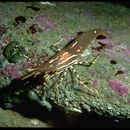Look Alikes
provided by Invertebrates of the Salish Sea
How to Distinguish from Similar Species: This is the largest shrimp on the west coast of North America. The large size and white spot on the abdomen are distinctive. Pandalus tridens has a 6th abdominal segment 3 times as long as wide.
- license
- cc-by-nc-sa
- copyright
- Rosario Beach Marine Laboratory
Habitat
provided by Invertebrates of the Salish Sea
Subtidal rocky and sandy habitats. We frequently catch them on by otter trawl in the San Juan Channel on bottoms of shelly hash. Juveniles come shallower, even into the lower intertidal zone where they hide in crevices and under boulders during the day.
- license
- cc-by-nc-sa
- copyright
- Rosario Beach Marine Laboratory
Distribution
provided by Invertebrates of the Salish Sea
Geographical Range: Unalaska, Alaska to San Diego, CA; Sea of Japan and Korea Strait
- license
- cc-by-nc-sa
- copyright
- Rosario Beach Marine Laboratory
Habitat
provided by Invertebrates of the Salish Sea
Depth Range: Low intertidal to 487 meters. Mostly well below the intertidal zone.
- license
- cc-by-nc-sa
- copyright
- Rosario Beach Marine Laboratory
Comprehensive Description
provided by Invertebrates of the Salish Sea
This large benthic shrimp has the typical multiarticulated second pereopod and long rostrum characteristic of family Pandalidae. Antenna 1 is only about as long as the carapace. Abdominal segment 3 does not have a median dorsal ridge and spine. Only the anterior half of the carapace has median dorsal spines. Abdominal segment 6 is less than twice as long as wide. This species is reddish with longitudinal white stripes on the carapace and a distinctive white spot on the sides of the first and fifth abdominal segments. Their pereopods and antennae are banded dark red and lighter red or white. Juveniles may be red, or may be brown or green. The abdomen is smooth and shiny but the carapace is covered with a fuzzy layer of short, fine setae.
- license
- cc-by-nc-sa
- copyright
- Rosario Beach Marine Laboratory
Comprehensive Description
provided by Invertebrates of the Salish Sea
Biology/Natural History: A common inhabitant of deep sandy bottoms in the Rosario area. Feed on crustaceans, polychaetes, limpets, and carcasses. One important predator is the giant octopus Octopus dofleini and the yelloweye rockfish Sebastes ruberrimus. One interesting feature about this species is that it has a different number of multiarticulations on the carpus of its two second pereopods: The left pereopod has 27-31 articles and is longer, while the shorter right second pereopod has only 8 or 9 articles on the carpus. Breeding ends in late October. Females carry their eggs on the abdomen for 4-5 months, remain in deep water. Eggs hatch in March or April. Larvae settle from the plankton in May and June. Juveniles feed in shallow water during summer, especially among Agarum fimbriatum and A. clathratum kelp. They seem to avoid Laminaria saccharina. During their second fall they become males, which they remain until they grow to 3.3 cm carapace length, at which time they become females. Females may mate only once. May not live longer than 4 years. These shrimp are very common on the bottom in the deeper portions of the Salish Sea. At depths over 70 m in the Salish Sea area they aggregate on shallow-slope bottoms near deposits of drift kelp, on which they feed
- license
- cc-by-nc-sa
- copyright
- Rosario Beach Marine Laboratory
Pandalus platyceros
provided by wikipedia EN
Pandalus platyceros, also called California spot prawn (as well as Santa Barbara spot prawn and Monterey Bay spot prawn[2]) or Alaskan prawn, is a shrimp of the genus Pandalus.[1]
Spot shrimp are a large shrimp found in the North Pacific. They range from the clean waters off Unalaska Island, Alaska, to San Diego. The commercial spot prawn fishery along the British Columbia coast is considered sustainable[3] as they "occur in sufficient numbers to support several small commercial and recreational fisheries"[4] and provides the largest landed value to the BC shrimp fishery.
Distribution
Pandalus platyceros are found throughout the marine waters of the North Pacific Ocean.[5] While found living from 3.7 meters to 457.2 meters, spot shrimp are most often found around 109.7 meters below sea level.[6]
Description
Spot prawn reach up to 27 centimeters in length, with females often longer than their male counterparts. Spot shrimp have a translucent, reddish carapace with white stripes and pereopods and antennae which are banded dark and light red.[7] Their first and fifth abdominal segments have white spots.[6]
References

- license
- cc-by-sa-3.0
- copyright
- Wikipedia authors and editors
Pandalus platyceros: Brief Summary
provided by wikipedia EN
Pandalus platyceros, also called California spot prawn (as well as Santa Barbara spot prawn and Monterey Bay spot prawn) or Alaskan prawn, is a shrimp of the genus Pandalus.
Spot shrimp are a large shrimp found in the North Pacific. They range from the clean waters off Unalaska Island, Alaska, to San Diego. The commercial spot prawn fishery along the British Columbia coast is considered sustainable as they "occur in sufficient numbers to support several small commercial and recreational fisheries" and provides the largest landed value to the BC shrimp fishery.
- license
- cc-by-sa-3.0
- copyright
- Wikipedia authors and editors

